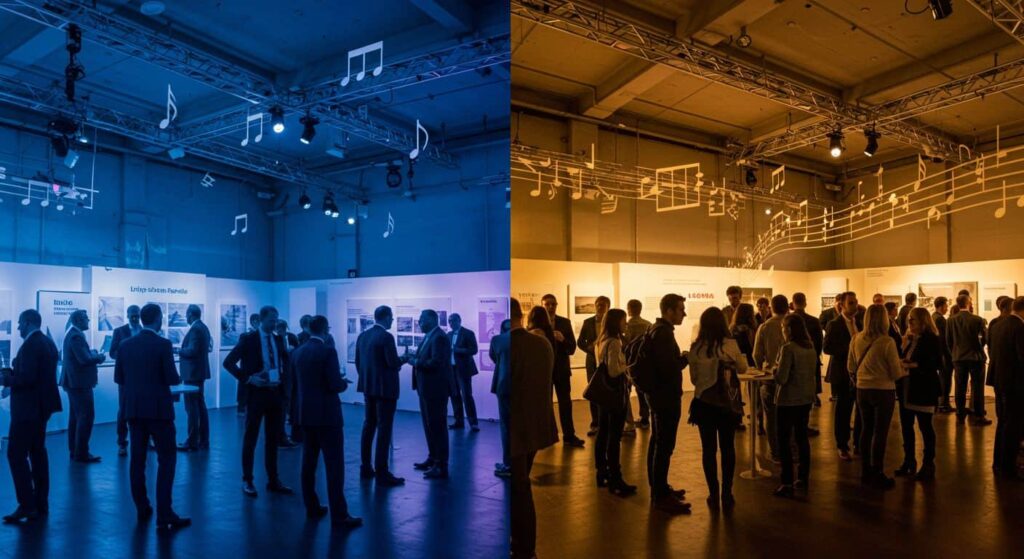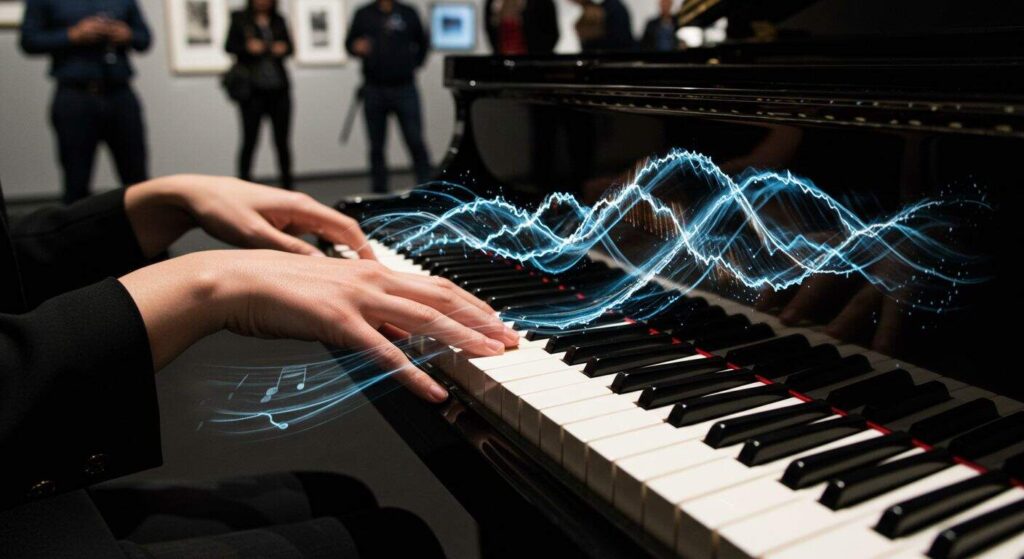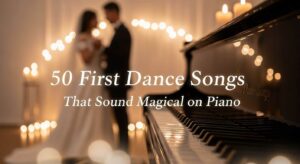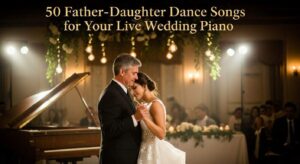Event planners often face the challenge of creating the perfect atmosphere. Live piano music can set the tone for an event, showing its power to shape moods and behaviors. This blog will explore how music tempo influences guest experience at events.
Keep reading to discover more secrets about tempo!
Key Takeaways
- Fast-tempo music enhances emotional arousal, leading to higher energy and variety-seeking behavior among guests. This can result in more engaging experiences as attendees explore different offerings at an event.
- Slow-tempo music often evokes feelings of calmness, encouraging longer stays in spaces such as exhibitions. While it might not boost excitement like fast-paced tunes, it allows for a more leisurely exploration, affecting shopping speed and decision-making processes.
- The tempo of background music affects consumer behavior significantly by shaping their mood and satisfaction levels. Event planners can use this knowledge to create atmospheres that positively influence guest perceptions and engagement with the environment or brand.
- Music’s pacing directly impacts customer decision-making, with faster tempos promoting quicker choices and enhanced engagement while slower rhythms may slow down cognitive processing but increase time spent interacting with products or services.
- Understanding the relationship between music tempo and atmosphere is crucial for event success. Selecting the right pace can enhance overall experiences, making events memorable by effectively boosting attendee satisfaction through careful manipulation of mood and space interaction dynamics.
Understanding Music Tempo and its Effects on Consumer Behavior

Music tempo plays a vital role in shaping consumer behavior. It influences emotional arousal, rhythm, and shopping speed, all of which can affect how guests interact with products and services.
Emotional arousal
Fast-tempo background music enhances consumers’ arousal levels. This increase leads to greater variety-seeking behavior among guests. Excitement and energy flow through spaces with lively beats.
As event planners, you can use this knowledge to create engaging atmospheres.
Slow-tempo music produces different emotional responses. It often evokes feelings of calmness but may also lead to longer participant stays in exhibition spaces compared to fast-tempo music.
Understanding these effects helps you shape the customer experience more effectively.
Tempo influences emotions and shapes guest experiences.
Variety-seeking behavior
Building on emotional arousal, variety-seeking behavior plays an essential role in consumer interactions. Fast-tempo background music enhances consumers’ arousal levels. This boost often drives them to seek out new and diverse experiences.
As a result, guests become more willing to explore different offerings at events or venues.
Consumers often do not stay fixed on one option for long when fast-paced music fills the air. Instead, they quickly shift their attention from one exhibit or product to another. Slow-tempo music does not promote this same level of exploration.
In fact, it typically leads to longer stays in exhibition spaces because attendees feel less urgency to move along. Understanding these patterns can help event planners create engaging environments that cater to the influence of music tempo on customer experience and guest satisfaction.
Rhythm
Rhythm plays a crucial role in shaping guest experiences. Fast-tempo music can boost emotional arousal, making customers feel more excited and lively. This heightened energy drives variety-seeking behavior, encouraging guests to explore different offerings.
In contrast, slow-tempo music leads to longer stays in exhibition spaces. Guests often linger longer when they hear slower beats, as the pace allows for relaxation.
Understanding the rhythm of background music is essential for creating the right ambiance. A well-chosen tempo influences not only customer mood but also affects their decision-making process.
The beat sets the tone of an event and impacts overall customer perception immediately after entering a space. Moving forward, we will explore how different tempos influence customer engagement further and affect decisions made during events.
Shopping speed
The tempo of background music significantly influences shopping speed. Fast-tempo music leads to quicker decision-making and shorter stay durations in retail spaces. Customers often feel excited and energized when fast-paced tunes play, prompting them to move more swiftly through their shopping experience.
In contrast, slow-tempo music encourages longer stays and a leisurely pace. This slower rhythm can boost customer satisfaction as guests take their time exploring products.
Understanding the impact of background music tempo on consumer behavior is crucial for event planners aiming to create engaging atmospheres. By selecting the right musical pacing, you can enhance guest experience and influence mood effectively.
For example, using upbeat tracks may encourage visitors to browse diverse offerings while enjoying a lively environment that boosts overall satisfaction with your event or venue.
Influence of Music Tempo on Customer Experience
Music tempo plays a crucial role in shaping customer experiences. Faster rhythms can energize guests, while slower tempos create a calm atmosphere. This music choice directly impacts guest satisfaction and mood.
Adjusting the pace helps set the right tone for events. Event planners should consider how music influences engagement to enhance overall enjoyment. Explore how these elements connect with guest perception further in our discussion!
Impact on guest satisfaction
Fast-tempo background music increases emotional arousal. Guests feel happier and more excited in a lively environment. This heightened mood enhances their overall satisfaction during events.
In comparison, slow-tempo music may evoke different emotions. It leads to longer stays but might not impact guest enjoyment as effectively.
The influence of music tempo on customer experience shows that background music affects how long guests linger in a space. Positive feelings associated with fast tempos often lead to better attitudes toward a brand.
Music’s role is crucial for shaping the atmosphere of an event, impacting guest perception significantly. Event planners must consider these factors to create engaging environments that boost satisfaction levels among attendees.
Effect on customer mood
The impact of music tempo on customer mood plays a crucial role in event planning. Fast-tempo background music evokes positive emotions such as happiness, excitement, delight, and liveliness.
Guests feel more vibrant and engaged in an upbeat atmosphere. In contrast, slow-tempo music can create a calming effect but may lead to different emotional responses.
Music pacing directly influences how attendees perceive their experience. A relaxed pace allows for longer stays in exhibition spaces compared to faster tempos that encourage movement.
The emotional response to these varying tempos highlights the need for careful selection of background music at events. Event planners must consider the relationship between music tempo and consumer behavior to enhance overall guest satisfaction and enjoyment.
Relationship with atmosphere
A connection exists between music tempo and the atmosphere of an event. Fast-tempo music creates a lively environment that energizes guests. It helps evoke positive emotions such as happiness, excitement, and delight.
This upbeat mood leads to increased guest satisfaction. Slow-tempo music, in contrast, fosters a calmer atmosphere that encourages longer stays in spaces like exhibitions. The slower pace may slow cognitive processing speed, which can affect how guests interact with their surroundings.
Music’s role goes beyond mere background noise; it shapes customer perception of your brand and affects their movement within the space. A well-structured audio environment enhances overall experiences for attendees.
Event planners should consider these aspects carefully when selecting appropriate soundtracks to match the desired ambiance and optimize engagement levels at events.
The Role of Music Pace in Customer Engagement
Music pace significantly influences how customers engage with a brand. A faster tempo can energize shoppers and encourage quicker decision-making, while a slower beat helps create a more relaxed atmosphere.
Effect on decision-making
Fast-tempo music has a strong effect on decision-making. It raises emotional arousal levels, which can push consumers to make choices quicker. This quickened pace often leads them to seek variety in their options.
In contrast, slow-tempo music may hamper cognitive processing speed, resulting in less effective performance when making decisions.
Event planners should consider these dynamics when selecting background music for events. The tempo influences customer perception and engagement with the environment. Faster tempos tend to create feelings of happiness and excitement that can enhance guest satisfaction.
These emotions play a significant role in how guests approach decisions during an event or exhibition space.
Impact on customer perception
Effective decision-making influences customer perception significantly. Music tempo plays a vital role in this process. Fast-tempo music evokes emotions like happiness and excitement.
Guests often associate these feelings with the brand, improving their view of it. Studies show that emotional responses to music impact customers’ attitudes toward businesses.
Slow-tempo music can have the opposite effect. It may lead to negative customer perceptions and lower satisfaction levels. The background music tempo shapes how guests feel about their experience as well as the atmosphere of an event space.
A carefully chosen tempo can enhance guest perception and create a lasting impression on attendees, ultimately affecting overall satisfaction.
Conclusion
Music tempo deeply influences guest experiences. Fast-paced tracks boost arousal and encourage guests to explore more. Slow beats create a calming atmosphere, promoting longer stays in spaces like exhibitions.
The right music enhances customer mood and satisfaction. Understanding these effects can help event planners create memorable occasions for every guest.
FAQs
How does music tempo impact the guest experience?
Music tempo can greatly affect a guest’s perception and their overall experience. The pace of the background music influences their mood, engagement level, and even their decision-making process.
What is the effect of music tempo on consumer behavior?
The speed or slow pace of background music can influence variety-seeking behavior in consumers. It has an impact on shopping habits and customer satisfaction levels.
How does musical pacing play a role in customer engagement?
The pacing of music can stimulate emotional responses that enhance customer engagement. A well-chosen tempo can make customers feel more connected to the entertainment environment.
Can changing the pace of background music alter a guest’s mood?
Yes, there’s evidence that different tempos elicit varying emotional responses from guests which affects their mood significantly during their visit or shopping experience.
Does altering the speed of background songs have any effects on decision making?
Absolutely! Research shows that changes in song speed can impact consumer decision-making processes by influencing how they perceive time and products available for purchase.
How does music tempo impact the guest experience? Music tempo can greatly affect a guest’s perception and their overall experience. The pace of the background music influences their mood, engagement level, and even their decision-making process.
What is the effect of music tempo on consumer behavior? The speed or slow pace of background music can influence variety-seeking behavior in consumers. It has an impact on shopping habits and customer satisfaction levels.
How does musical pacing play a role in customer engagement? The pacing of music can stimulate emotional responses that enhance customer engagement. A well-chosen tempo can make customers feel more connected to the entertainment environment.
Can changing the pace of background music alter a guest’s mood? Yes, there’s evidence that different tempos elicit varying emotional responses from guests which affects their mood significantly during their visit or shopping experience.
Does altering the speed of background songs have any effects on decision making? Absolutely! Research shows that changes in song speed can impact consumer decision-making processes by influencing how they perceive time and products available for purchase.
For more insights on enhancing your event experience with professional live music, call (732) 995-1082, visit our blog or contact us for a consultation.





